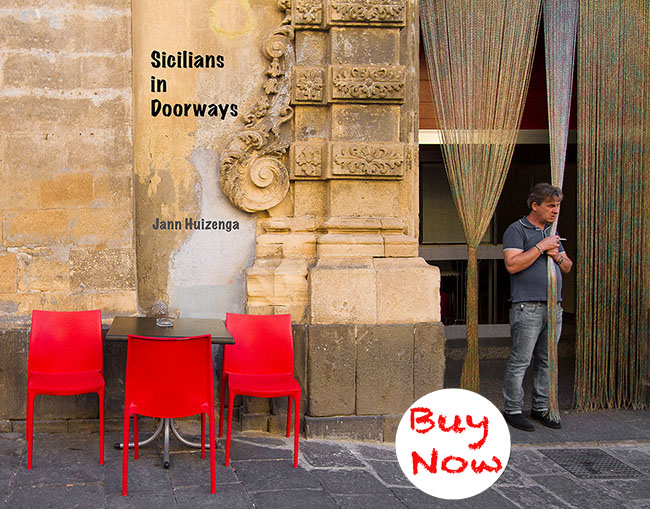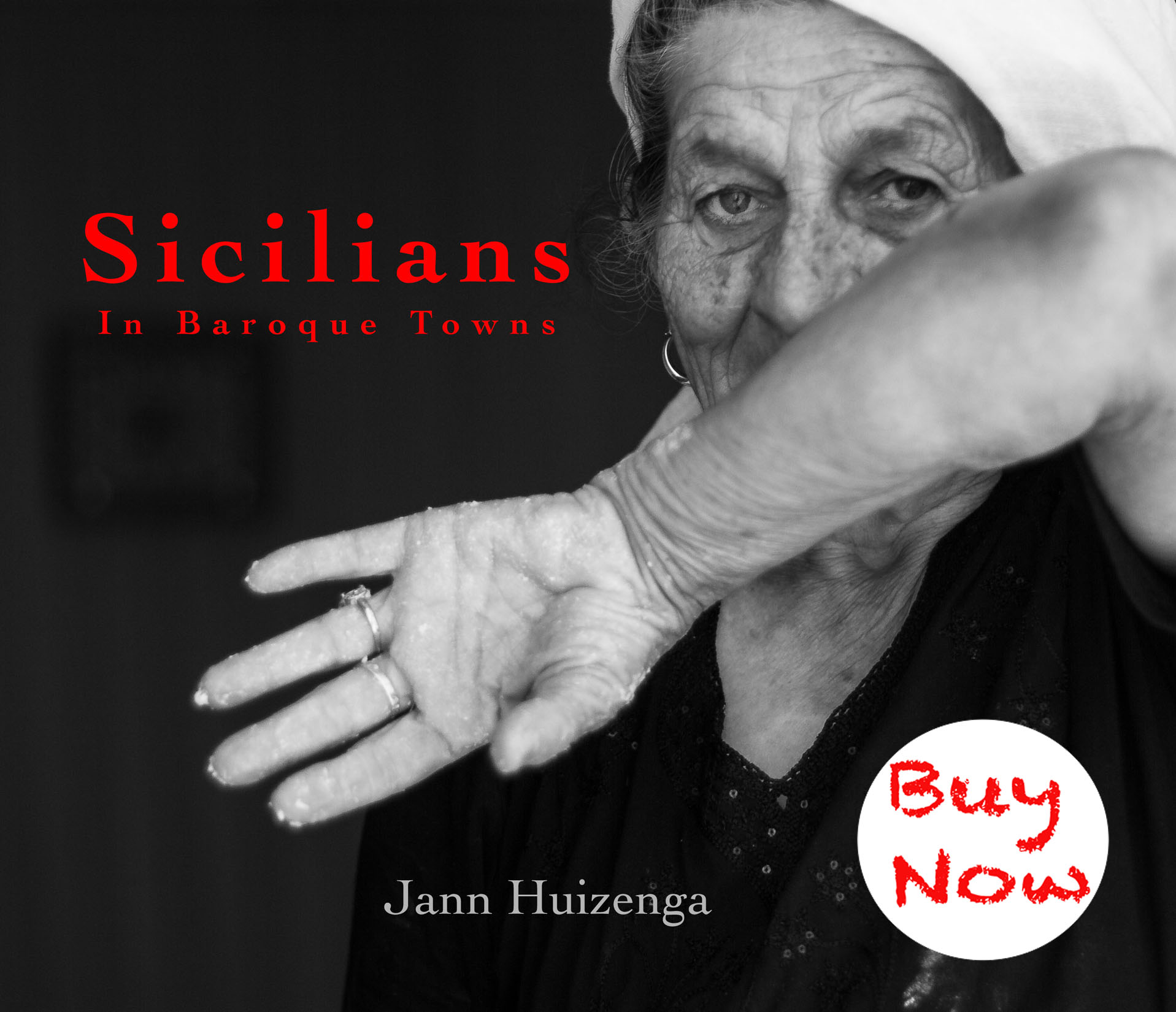May 25, 2010
Can you say that five times, fast?
Pronounced chic-ly, Scicli is not at all chic, though I suppose you could call it shabby chic. It’s got that vintage, distressed look—complete with a baroque voluptuousness, flakey paint, and mottled sandstone walls.

Go if you like out-of-the-way little gems.
It was a Moorish town a millennium ago, later a Norman one, and was rebuilt in the Baroque style after the 1693 quake. Then Time forgot little Scicli until it was declared a World Heritage Site in 2002. It is slowly waking up from a long torpid slumber.

It has its share of ogres, meant to keep foreigners and evil spirits at bay.

Hike up to the decaying Church of San Matteo if you dare. You’ll be amply rewarded with stunning views: a sapphire sea on your left and a town that looks like a stage set at your feet.
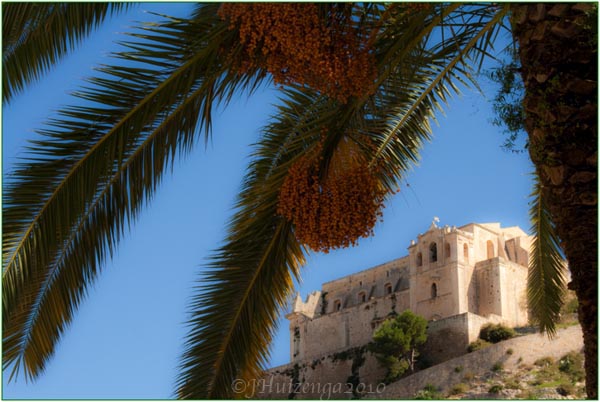

xxx
The best place in town for lunch is Pomodoro, owned by Enrico Gugliotto (pictured here) and his brother Giuseppe (in the kitchen). It’s about a five minute walk from the baroque heart of Scicli (Corso Garibaldi 46, closed Tuesday, 0932.931.444).
And check out the gorgeous Scicli cemetery if you’re into stone cherubs and angels. It’s just outside of town.
[gmap]
Click to leave a comment.
Click to subscribe.

Readers, can you help me? Will you consider voting for my Sicily photograph in the Islands poll? Here’s the link. The link will bring you to a photo I shot of a Sicilian woman in Capo Passero (in the extreme southeast corner of Sicily). You can vote by clicking on *My Favorite* underneath the photo. (I could win a photography course and you could win a camera!) GRAZIE MILLE! (To see thumbnails of all 22 photos in the competition, click this link.)
March 30, 2010
Surprise! The 20th-century layers have been chipped off my walls, and I think we’ve found—in addition to big old blocks of Norman stone—some traces of Arab architecture.
North African Moors ruled Sicily for only a couple of centuries more than a millennium ago, but their influence on the island was, and is, huge.
Before I show you my little discovery, take a good look, if you will, at these keyhole-shaped doorways in North Africa.

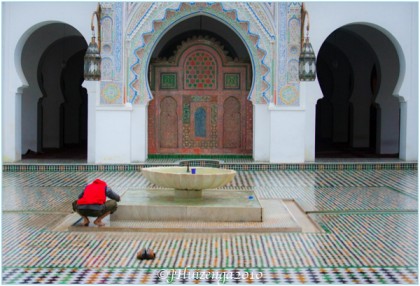
OK, now compare those doorways with the one below in my house. The arch shape turned up when we pulled off the modern wooden door frame. Don’t you think it looks vaguely Moorish in design?
 It’s not as beautiful as those North African doors, I know, and the curved thingamajig is way up top rather than in the middle of the arch, but still … it makes me wonder. It’s certainly not a pure Roman or Greek arch (more on that below). It’s not as beautiful as those North African doors, I know, and the curved thingamajig is way up top rather than in the middle of the arch, but still … it makes me wonder. It’s certainly not a pure Roman or Greek arch (more on that below).
I now have three of these vaguely Moorish arches on the top floor of my casa.
The house is a historical puzzle. The top floor, I’m quite sure, was built sometime soon after the 1693 earthquake that leveled not just Ragusa Ibla, but much of southeast Sicily. As I’ve mentioned earlier, the stone blocks in this doorway and elsewhere in the house were looted from the Norman castle that stood on this site and crumpled in that quake. (I know this only because neighbors have told me.)
So, assuming the above timeline, this means that 700 years after the Moors left Sicily, local Sicilian builders still carried traces of their Arab heritage in their builders’ DNA.
Everything here is so knotted and twisted together; it’s hard to tease out the many strands of history from all the superimposed cultures and styles. Layers upon layers—that’s what Sicily is all about.
The house becomes older the lower you go. The bottom floor used to be a cantina, a place where wine was made and stored (soon to be guest quarters). The arch down there seems Greco-Roman in style, an uninterrupted curve.
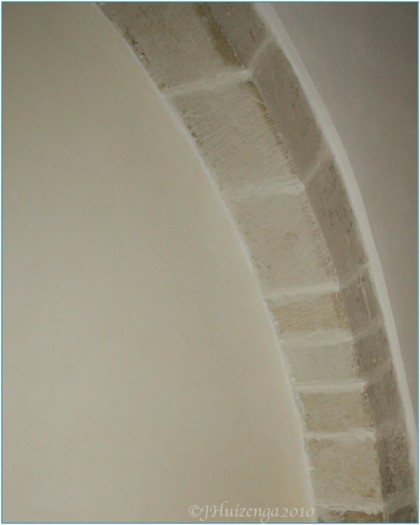
When was it constructed? Stay tuned. Maybe someday I’ll figure it out. Perhaps you have an insight?
***
For more on the Muslim rule of Sicily, click here.
***
Click to leave a comment.
Click to subscribe.
January 15, 2010
Baroque Sicily is

stone the color of fresh-baked bread;

scary souls in spectacles;

Sirens and

saints;

seraphim and
 seashells; seashells;

spirals and squiggles and
 scrolls and swirls. scrolls and swirls.
 A symphony of sandstone. A symphony of sandstone.
Ah, Sicily. See-chee-lya. Sikelia.
***
Leave a Comment
Please Subscribe. It’s Free!
January 12, 2009
A reader emailed to ask me about Arab influences in southeast Sicily—in addition to the majolica mentioned in my last post.
There are so many leftover traces!
I want to share a personal story.
Do you see the man on the left, in the baseball cap? That’s Emanuele, assistant to my beloved (new) stonemason, Giorgio, the cap-less fellow, who warbles Sicilian love songs as he works, though that’s beside the point.

Here is a typical exchange between Emanuele and me:
Me, shaking his hand: A domani! See you tomorrow!
Him: Se Dio lo vuole, if God wills it.
Me: I think you’ll be able to finish tiling around the bidet.
Him: Se e la voglia di Dio, if it is the will of God.
When I first met Emanuele, I’d just returned from Morocco, where Inshallah, God willing, is a constant refrain. The fact that he used the same refrain astonished me. Curiosity got the better of me and I asked if he was Muslim.
His eyes bulged from their sockets at this suggestion, and his head jerked back on his thick neck (an Arab gesture for no.). Gianna, no! Ma che dici! Sono cattolico! Sono proprio, cento percento, cattolico!”
Scratch a Sicilian, I heard somewhere, and you’ll find a Saracen. Never mind that the two-plus centuries of Arab domination of the island ended more than a millennium ago.
*****
NOTE: There’s a new book written by Alfonso Campisi, Ifriqiyya and Sicily: A Mediterranean Twinning, that retraces Sicily’s Arab history, but I haven’t been able to find it online. For a good summary on Arabs in Sicily click this link to Best of Sicily Magazine.
Won’t you please subscribe to this blog? It’s free!
Leave a Comment
January 10, 2010
In my new incarnation as a siciliana, I look around wide-eyed. Then I
mimic
copy
follow
ape
echo.

Above is my version of the famous staircase at Caltagirone. The 25 tiled steps are disturbingly steep and narrow, a sheer cliff that I scale like a mountaineer.
The real deal in baroque Caltagirone is wide and grand—142 steps high and the size of a two-lane highway.
 
The old scala—tiled in the 1950s—bears motifs from as far back as the 10th century and bursts with vivid Caltagirone colors: sunny citrus, shiny indigo, acid green. There are mythic birds and beasts, nobles, flowers, and geometric designs. Sicilians learned majolica production from the Arabs, who had a “monumental influence” on Sicily, and many of the Escher-like designs of North African zellij found their way here.
My tumbledown staircase turned into an ordeal, the way these things do. The work dragged on for a year and a half, longer than it took to tile the entire grand staircase at Caltagirone.
Come è possibile, you ask?
Well, I measured only one step before placing the entire order for 100 hand-painted tiles, assuming the steps were of equal size.
Oh, you naïve straniera you.
My stonemason shook his head sadly and managed to grind down some of the tiles without spoiling the designs too much—and even chink-chinked away at some of the too-small steps. But for the too-big steps I measured again, ordered again, waited again, dashed back and forth to Caltagirone, waited some more.
Not only that: I had to sack the mason for an unrelated disaster in the middle of things (a blog topic for later if I dare).
In the end, though, my pesky staircase has gotten hold of my heart. It’s sweet. “Nun si mancia meli senza muschi,” as Sicilians say. You can’t eat honey without flies.

Won’t you please subscribe to my blog? It’s free!
Leave a Comment
|
Subscribe to Baroque Sicily
Copyright reserved -
All photos and text on BaroqueSicily are Copyright of Jann Huizenga ©2009-2015, unless otherwise noted. Material may not be copied or re-published without written permission. All rights reserved.
|








 It’s not as beautiful as those North African doors, I know, and the curved thingamajig is way up top rather than in the middle of the arch, but still … it makes me wonder. It’s certainly not a pure Roman or Greek arch (more on that below).
It’s not as beautiful as those North African doors, I know, and the curved thingamajig is way up top rather than in the middle of the arch, but still … it makes me wonder. It’s certainly not a pure Roman or Greek arch (more on that below).














